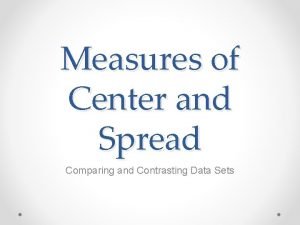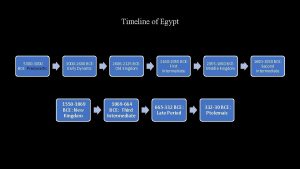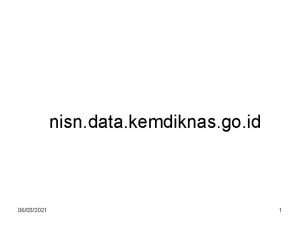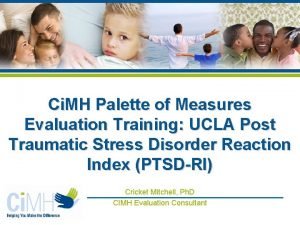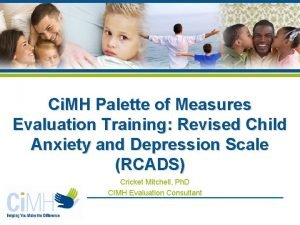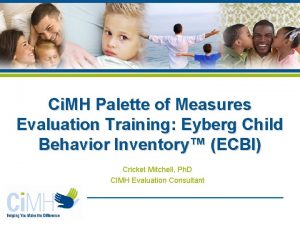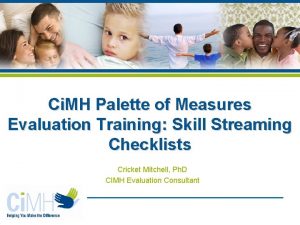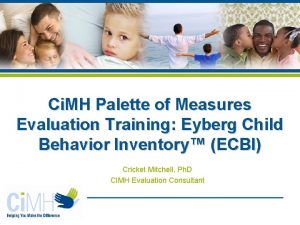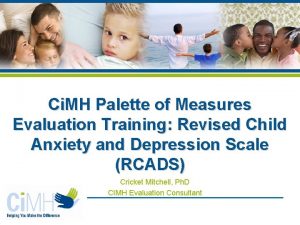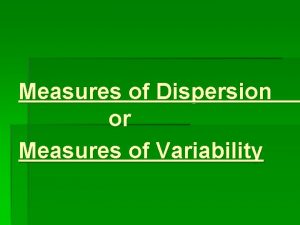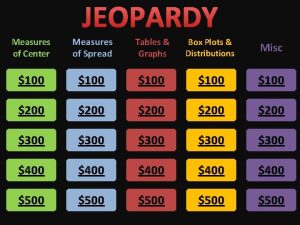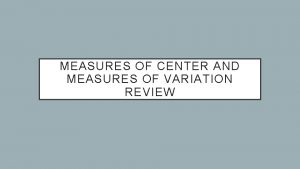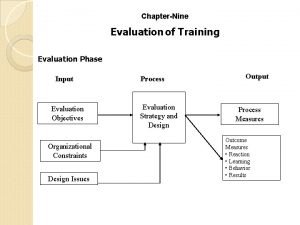Ci MH Palette of Measures Evaluation Training Center




































- Slides: 36

Ci. MH Palette of Measures Evaluation Training: Center for Epidemiological Studies – Depression Scale (CES-D) Cricket Mitchell, Ph. D CIMH Evaluation Consultant

Palette of Measures Evaluation: What You Will Need (slide 1 of 2) • Palette of Measures Data Entry Shell v 2 (Excel file) – Developed by Ci. MH and customized for each participating agency – Holds all data for clients served thru the Palette of Measures project – Demographics, service delivery information, pre- and post- outcome measure data • Palette of Measures Data Dictionary v 2 (Word document) – A guide for using the associated data entry shell – Defines each column in the excel file 2

Palette of Measures Evaluation: What You Will Need (slide 2 of 2) • Outcome measures from the two-pronged approach – General Outcome Measure – Target-Specific Outcome Measure(s) – For example… • Center for Epidemiological Studies – Depression Scale (CES-D) – Public domain, no fee for use 3

Overview of Training • Brief Overview of Palette of Measures evaluation protocol • Center for Epidemiological Studies – Depression Scale (CES-D): Target-specific measure when the focus of treatment is depression – Administration – Scoring – Clinical Utility • Instructions for Palette of Measures data entry and data submissions – Data entry: CES-D – Data entry: Demographics & Services – Data submissions to Ci. MH 4

Brief Overview of Palette of Measures Evaluation Protocol 5

Outcome Assessment • Palette of Measures providers will track outcomes using data from pre- and post- administrations of standardized measures of functioning • Pre- and Post- a “dose” of treatment / an intervention interval – General measure of youth mental health functioning (e. g. , YOQ/YOQ-SR, CANS, Ohio Scales) – Target-specific measure linked to focus of treatment/intervention (e. g. , AQ, ECBI, PHQ-9, PTSDRI, RCADS) • Providers may choose to administer mid-course assessments as well – e. g. , at 3 -month intervals in usual care 6

A note about the use of standardized assessment measures… (slide 1 of 2) • Assessment is the beginning of developing a relationship with the child and family – Demonstrates a desire to know what the child and family are experiencing – By incorporating standardized assessment measures of functioning, the efficiency and thoroughness of assessment is enhanced 7

A note about the use of standardized assessment measures… (slide 2 of 2) • Using standardized assessment measures of functioning… – Assists in initial clinical impressions – Provides valuable information to guide treatment/interventions – Assesses sufficiency of treatment delivered – Demonstrates treatment-related improvements in child functioning 8

Center for Epidemiological Studies - Depression Scale (CES-D) 9

Ci. MH CES-D Training • Information on the administration, scoring, and clinical utility of the CES-D was obtained from on-line resources published by the Oregon Health & Science University and by the University of North Carolina at Chapel Hill, LONGSCAN studies 10

CES-D Description • Target specific measure for depression • Measures depressive symptoms experienced in the previous week – Self-report for ages 12 and older • 5 minutes to complete • Available in English and Spanish 11

CES-D Description • Valid and reliable • Sensitive to clinical change • Available in the public domain, provided to partnering agencies by Ci. MH 12

CES-D Description • 20 items • 4 -point Likert scale response options* • Total Score – Rarely or none of the time (0) – Some or a little of the time (1) – Occasionally or a moderate amount of time (2) – Most or all of the time (3) *All positive items are reverse-scored 13

CES-D Description • The 20 items on the CES-D reflect six major dimensions of depression – Depressed mood – Feelings of guilt and worthlessness – Feelings of helplessness and hopelessness – Psychomotor retardation – Loss of appetite – Sleep disturbance 14

Example: Items from the CES-D • I was bothered by things that usually don’t bother me. • I felt depressed. • I felt hopeful about the future. • My sleep was restless. • I talked less than usual. • I was lonely. 15

CES-D Administration • Administer pre- and post- a dose of treatment, or an intervention interval, focused on depressive symptomotology – CES-D completed by client – Some agencies may choose to administer mid -treatment assessments as well 16

Let’s take a look at the CES-D. . . 17

CES-D Administration • Less than 5 minutes to complete • When in doubt, administer the measure aloud – Readability is age 12 • Ensure that the respondent is clear about the timeframe – “. . . how you have been feeling during the past week. ” • Ensure all items are completed – Leave no blanks 18

CES-D Scoring • Four of the 20 items are phrased positively to control for response bias 4. I felt that I was just as good as other people. 8. I felt hopeful about the future. 12. I was happy. 16. I enjoyed life. 19

CES-D Scoring • Response values for each item response are on slide 13 • Re-code/reverse-score the positively phrased items: 4, 8, 12, and 16 – For these four items only: • 3=0, 2=1, 1=2, and 0=3 • Once the four positively phrased items have been reverse-scored, sum up all of the item responses (items 1 -20) 20

CES-D Scoring • Possible scores on the CES-D range from 0 to 60 • A score > 16 indicates mild to moderate depressive symptomotology • A score > 21 indicates significant depressive symptomotology 21

Clinical Utility of the CES-D • Screening tool – Can be used to identify those in need of further assessment and/or treatment targeting depression • Treatment planning – Total Score indicates the severity of current depressive symptomotology – Items scored with a 2 or a 3 indicate specific symptoms of distress to be targeted in treatment • Monitoring clinical progress – Can be administered weekly, if desired 22

Clinical Utility of the CES-D • Comparisons of pre/post scores reveal areas of clinical improvement – e. g. , • Does the youth’s severity of depressive symptomotology decrease substantially? • Is there improvement across all specific symptoms of significant distress at the time of enrollment in treatment? 23

Palette of Measures Data Entry and Data Submissions 24

Palette of Measures Data Entry Shell • There is a separate spreadsheet in the excel workbook (aka database) for each type of data: – Demographics & Services – Pre- General outcome measure – Post- General outcome measure – Pre- Target-specific measure(s) – Post- Target-specific outcome measure(s) • Specific outcome measure spreadsheets included in each agency’s database varies across Palette of Measures project participants 25

Palette of Measures Data Entry Shell • In addition to the spreadsheets that hold data. . . – There is an Instructions spreadsheet • Basic data entry instructions • Contact information for T. A. (Cricket Mitchell) – There is a Data Lists spreadsheet at the end of the workbook that you will not use • Data Lists populate the pull-down menus in other spreadsheets 26

Palette of Measures Data Entry: CES-D Pre-CES-D Self-Report (ages 12+) Date of Client ID# Assessment CESDTot 1 • There is a separate spreadsheet for Pre- CES-D data, Post- CES-D data, and Mid- CES-D data • In each spreadsheet, there is a field for the CES-D Total Score • In the event of missing data, leave the fields blank/empty. Do not enter text into any of the fields. 27

Palette of Measures Data Entry: CES-D Mid-CES-D Self-Report (ages 12+) Date of Assessment Client ID# Assessment Interval CESDTot. M • For agencies who will conduct mid-treatment assessments, indicate the Assessment Interval in the Mid-CES-D spreadsheet by selecting from the available pull-down menu • e. g. , 1 st mid-treatment assessment, 2 nd mid-treatment assessment 28

But, before you enter any outcome data, you’ll enter Demographics & Service Delivery Information. . . 29

Palette of Measures Data Entry: Demographics & Services (1 of 2) Client Information: Client ID# DOB Primary (DSM-IV code) Gender Ethnicity Language Primary Axis I Secondary Axis I Therapist ID • Use a unique identifier for Client ID# • Categorical variables will have pull-down menus from which you’ll select an option (e. g. , gender, ethnicity, language) • Dates should be entered as xx/xx/xxxx • Axis I diagnoses s/b the numeric DSM-IV code • Therapist ID is optional 30

Palette of Measures Data Entry: Demographics & Services (2 of 2) Focus 1 of Treatment Date of First Session Focus 1 Date of Total # Completed Last of Sessions Focus 1? (if Focus 1 not completed) Completed (if Services not completed) Reason Services? Reason • Select Focus from pull-down menu (e. g. , anxiety, depression) • The shell will hold data for up to 4 foci, or treatment targets • Enter Date of First Session • The remaining fields are to be completed at the end of treatment targeting this particular focus (e. g. , Date of Last, # Sessions) • 2 levels of “Completed? ” • Treatment targeting this particular focus • Overall service delivery 31

Palette of Measures Data Submissions (slide 1 of 3) • Data submissions to Ci. MH will occur twice a year throughout the duration of the project – The end of each May (reflecting all clients served from the initiation of the project through the end of that April) – The end of each December (reflecting all clients served from the initiation of the project through the end of that November) – Note that this is the anticipated schedule; actual data submission dates may vary slightly • An email notice will be sent to Palette of Measures site leads approximately one month in advance of each data submission deadline 32

Data Submissions (slide 2 of 3) • Providers may choose from among the following methods for submitting their Palette of Measures Excel databases to Ci. MH: – Use You. Send. It, or another secure web-based transfer site, to submit data electronically • You. Send. It (www. You. Send. It. com) is a vendor that supports the secure transfer of electronic data (encrypted and passwordprotected) – Mail a password-protected CD to Ci. MH and submit the password separately (via email or phone) – Email an encrypted, password-protected file(s) to Ci. MH and submit the password separately (via email or phone) 33

Data Submissions (slide 3 of 3) • After data are submitted, sites continue to enter new data into the same database – Always reflects an ongoing, historical record of clients served through the Palette of Measures project • Every effort is made to distribute reports within two months of each data submission – Aggregate and site/agency-specific reports 34

Questions 35

The End Contact Information • Cricket Mitchell, Ph. D • Email: cmitchell@cimh. org • Cell phone: 858 -220 -6355 36
 Repeated measures design
Repeated measures design Measures of center and spread worksheet
Measures of center and spread worksheet Module 7 weights and measures
Module 7 weights and measures Identify
Identify Asu color palette
Asu color palette Pace palette results
Pace palette results Uld avion
Uld avion Anapath meaning
Anapath meaning Spanish color palette
Spanish color palette Origin
Origin America color palette
America color palette Narmer palette meaning
Narmer palette meaning Root cern color palette
Root cern color palette Gauguin color palette
Gauguin color palette Narmer palette meaning
Narmer palette meaning Bagian tengah navigator palette disebut…
Bagian tengah navigator palette disebut… Palette of king narmer
Palette of king narmer Color theory kids
Color theory kids Pace palette assessment
Pace palette assessment Rcads scoring excel sheet parent
Rcads scoring excel sheet parent Sesbi
Sesbi Palette de tony cragg
Palette de tony cragg Color grey symbolism in literature
Color grey symbolism in literature Khan academy sat
Khan academy sat Palette humérale
Palette humérale Meat color
Meat color Chute
Chute Palette avion pmc
Palette avion pmc Equidistant color wheel
Equidistant color wheel Color 172006
Color 172006 Pace palette results
Pace palette results Violin and palette
Violin and palette Pace palette results
Pace palette results Reflexão
Reflexão Travée logistique
Travée logistique Pace palette assessment
Pace palette assessment Pace palette assessment
Pace palette assessment

